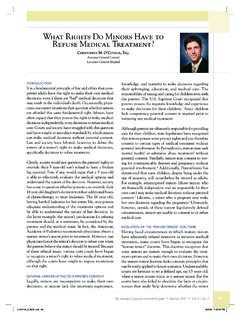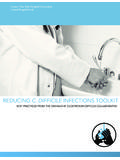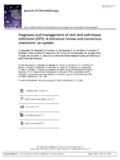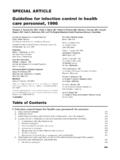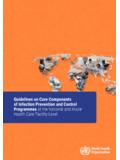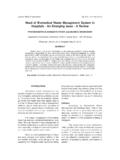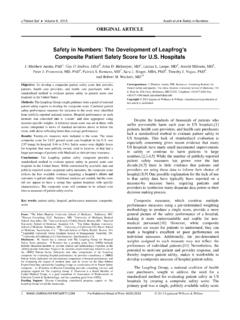Transcription of Evidence-Based Management of Severe Sepsis and Septic …
1 The journal of Lancaster General hospital Fall 2006 Vol. 1 No. 239 ABSTRACTS epsis remains a frequent and deadly diagnosis in hospitals across the United States. It continues to exact a heavy toll in morbidity, mortality, and resource consumption despite decades of intense research and technologi-cal advances. In the last few years, however, scientifi c endeavor has begun to defi ne intervention strategies that impact outcome. This article summarizes the current literature and expert opinion on this important topic, and suggests a specifi c approach to the Management of Sepsis in 750,000 cases of Sepsis occur in the United States annually, a rate of 3 cases per 100,000 population. In comparison, there are 900,000 cases of acute myocardial infarction per year, and 700,000 cases of acute stroke (1).
2 Crude mortality rates of Sepsis (29%), AMI (25%), and stroke (23%) are comparable as well. Mortality rates for patients who progress to Severe Sepsis or Septic shock are bleaker still, at 40% and 50% respectively (1). The excess cost attributable to the development of Sepsis is $22,100, which translates to an annual national cost of $ billion (1).DEFINITIONSDefi nitions established in 1992 by the American College of Chest Physicians and the Society for Critical Care Medicine Consensus, have withstood the test of time. The Systemic Infl ammatory Response Syndrome (SIRS) is a clinical syndrome that results from an exogenous stimulus that causes dysregulation of the body s homeo-static balance of pro- and anti-infl ammatory mechanisms. It can be triggered by such diffuse causes as trauma, burns, toxins, ingestions, pancreatitis, pulmonary barotrauma, and infection (2).
3 The diagnostic criteria for SIRS are summarized in Table 1. Sepsis is defi ned as SIRS resulting from a suspected or identifi ed infection. Severe Sepsis requires, in addition, evidence of hypotension or organ dysfunction, examples of which are listed in Table 2. Septic shock occurs when Severe Sepsis is refractory to fl uid resuscitation, or when pressor agents are required. TABLE 1: DIAGNOSTIC CRITERIA FOR SIRS core temp 38 C ( F) or 36 C ( F) heart rate 90 beats per minute respiratory rate 20 breaths per minite or PaCO2 32 mmHg wbc 12,000/mm3 or 4,000/mm3 or 10 % bands TABLE 2: CRITERIA FOR THE DIAGNOSIS OF Severe Sepsis BP 90 mmHg or MAP 70 mmHg for over 1 hr. Urine Output ml/kg/hr or acute renal failure PaO2/FiO2 250 Hepatic dysfunction Altered Mental Status Platelet count 80,000/mm3 or DIC pH and plasma lactate 4 mmol/LEvidence- based Management of Severe Sepsis and Septic ShockJOSEPH M.
4 KONTRA, Specialists of LancasterPATHOPHYSIOLOGYS epsis results when an infectious agent or its biochemi-cal products cause the host s normal protective infl am-matory response to become dysregulated and pervasive. This immunologic dissonance results in widespread tissue injury, and leads to a pro-infl ammatory and pro-coagulant milieu (2). It has perhaps been best described as malignant intravascular infl ammation, as it is unregu-lated, spreads beyond the original portal of entry, and is result of the infl ammatory storm of Sepsis is pro-gressive multi-system organ damage. This results from a unique and complex derangement of tissue perfusion and cellular dysfunction. In cardiogenic or hemorrhagic shock, a fall in cardiac output causes hypotension, hypo-perfusion, and anaerobic cellular metabolism.
5 398/23/06 4:21:26 PM8/23/06 4:21:26 PM40 The journal of Lancaster General hospital Fall 2006 Vol. 1 No. 2evidence- based managementIn Septic shock there is a far more complex interplay of pathologic vasodilation, altered fl ow distribution, relative and absolute hypovolemia, depression of myo-cardial function, and direct mitochondrial and cellular toxicities (3). MONITORING AND ENDPOINTSThe pathophysiology outlined above translates into clini-cal and laboratory parameters that provide the clinician with indicators of a patient s hemodynamic and perfu-sion status. These parameters also provide potential end points for resuscitation efforts, and serve as indicators of overall response to is a cardinal manifestation of Sepsis . Mean arterial blood pressure (MAP) below 65 mmHg portends inadequate perfusion and tissue hypoxia.
6 Nonspecifi c clinical manifestations of tissue hypoxia can include altered mental status, oliguria, ileus, and cutaneous changes. Central venous pressure (CVP) is an important indicator of the adequacy of fl uid resuscitation. Failure to rapidly achieve or maintain a CVP >8 mmHg has been cor-related with a poor prognosis in Severe Sepsis and Septic shock (3). A target CVP range of 8-12 mmHg is ideal. In mechanically ventilated patients on positive end expiratory pressure (PEEP), the target should be adjusted to at least 12-15 mmHg to compensate for increases in intra-thoracic variables such as central venous oxygen saturation (SVO2) or mixed venous oxygen saturation (SMVO2) may also provide evidence of tissue hypoxia. These measures, however, represent the algebraic sum of oxygenation in all venous return, and may therefore not refl ect relative distributive hypo-perfusion of certain organs.
7 Nonetheless, saturations below 70% correlate with global tissue hypoxia and a poor prognosis in Severe Sepsis and Septic shock (4).Biochemical indicators of tissue hypoxia and anaerobic metabolism include metabolic acidosis and elevated plasma lactate levels. Hyperlactatemia, in fact, can precede a fall in blood pressure in patients who are tran-sitioning from Sepsis to Severe Sepsis , and is therefore an important screening parameter in the febrile normo-tensive patient. It can result not only from anaerobic metabolism due to hypo-perfusion, but also from direct failure of cellular mitochondrial metabolism, increased glycolysis, and decreased clearance from the liver. In Severe Sepsis , blood lactate levels are of greater prog-nostic value than oxygen-derived measures, and a plasma lactate > 4 mmol/L indicates a poor prognosis.
8 THE SURVIVING Sepsis CAMPAIGNIn 2004, a consensus committee representing 11 pro-fessional organizations published the Surviving Sepsis Campaign (SSC) Guidelines for the Management of Severe Sepsis and Septic shock (5). This included 47 specifi c graded recommendations, based on a review of the then current literature. What follows is a review of selected recommendations, with updated references and AND INFECTION MANAGEMENTS epsis is by defi nition a consequence of infection. Efforts to identify and manage the clinical site of infection and to establish the microbiology are of critical importance. Although this seems intuitively obvious, studies indicate a surprising frequency of inadequate or absent workup, and suboptimal or inappropriate antibiotic therapy. In one large prospective trial of over 2,000 patients, treat-ment with antibiotics to which the offending organism was later shown to be resistant occurred in 32% of patients (6).
9 Mortality is reduced from 34% to 18% when appropriate antimicrobials are prescribed at the onset of Sepsis (7).The choice of antibiotics is based on the patient s history and physical exam, data collection including imaging studies, Gram stain data, and a knowledge of local and regional resistance patterns and epidemiology. The major sites of infection in Severe Sepsis and Septic shock, how-ever, remain either intra-abdominal (includes urinary) or pulmonary in over 90% of cases. The optimum timing of administration of antibiotics remains nebulous. SCC guidelines suggest that an anti-microbial regimen should be started within one hour of a diagnosis of Sepsis . There are, however, no published data that establish a crucial time to antibiotic interval. SSC also recommends that antibiotics be re-evaluated after 48-72 hours to determine the adequacy of the anti-microbials, and to wean those drugs not required (5).
10 In addition to antimicrobial treatment, Management of the infection source is crucial. Drainage of abscesses, 408/23/06 4:21:27 PM8/23/06 4:21:27 PM The journal of Lancaster General hospital Fall 2006 Vol. 1 No. 241evidence- based managementdebridement of devitalized tissues, and removal of potentially infected vascular catheters are examples of appropriate interventions. VOLUME RESUSCITATIONS epsis is characterized by capillary leak, a greatly expanded volume of fl uid distribution, and both abso-lute and relative hypovolemia. A critical early step in Management of the Septic patient is therefore aggressive volume expansion. Isotonic crystalloid with an initial infusion of 20 ml/kg has been advocated, with repeated boluses to rapidly achieve a CVP of 8-12 mmHg.
